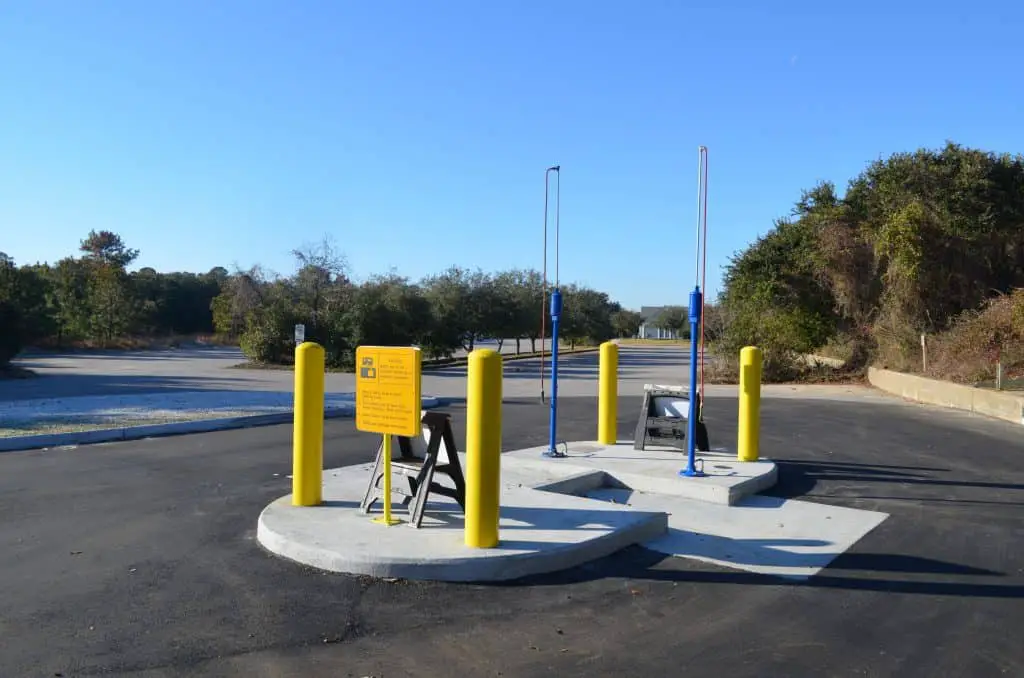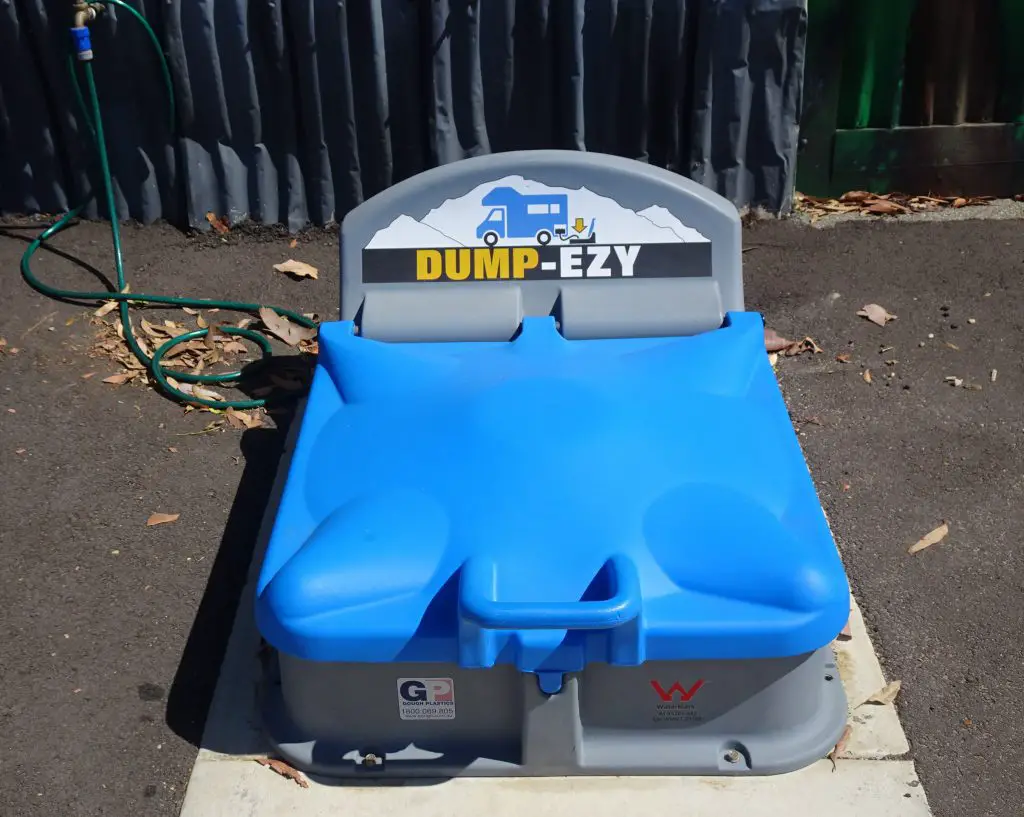Newbie RVers commonly ask how to use a dump point site and where are they. I have here just the exact answers. Not only that, but I will also share with you all other basics you have to know about RV dump points in Australia.
- What does an RV dump point look like?
- Dump points or dump ezy – Where are they in Australia?
- How to use a dump point site properly?
- The current issues about dump point sites
- How often should I dump my RV waste?
- Additional dump point tips
If you are a newbie or a foreign RVer, you may find it hard to find where the dump points are. You may even don’t know what they look like in the first place. Let alone how to use them the proper way. So let me show you this first:
What does an RV dump points look like?
In the US it’s more common for dump points to be in the form of a bare concrete slab, which is about 2 square metres in size and with a stub/inlet pipe out at its centre. On the other hand, most dump points in Australia are housed with a plastic (heavy-duty polyethylene) body and have a centre stub/inlet pipe too. These housings are branded as “dump ezy”, and are easier to spot while on the road because of their blue-coloured lids.
Here are illustrations to help you visualize:


Dump points or dump ezy – Where are they in Australia?
Let’s admit it, no matter how much we plan our trips there will always be emergency situations. And dumping your waste is one of them! So in case, such a thing happens, it’s good to know the typical locations where dump point sites are found.
Given the extensive camping culture in Australia, plenty of dump points are pretty much scattered all around the country. Aside from RV-designated areas (e.g. caravan parks, RV rest areas, etc.), here’s where dump point sites are usually found:
- Visitor Information Centres (VIC) – most large regional towns have a VIC
- Beside or near public toilets
- Public parks
- Showgrounds / roadhouses
- Petrol stations / truck stops
- By the road
But to help you be more prepared, I recommend that you carry with you a list of dump points you can refer to in case you immediately have to empty tanks. Specifically, ALL4RVs has an e-book containing this very list. Not only that but other nearby valuable facilities are also included such as but not limited to toilets, showers, water, rubbish bins and power. Great catch, right? For starters, here’s a snippet:
You can purchase the full e-book for $33.00. So click the button below.
How to use a dump points site properly?
Properly using dump points is actually as easy as 1-2-3. Here’s how:
- Park your RV as near as possible to the dump point.
- Gear yourself with PPE (personal protective equipment) – that is, gloves and boots. The boots aren’t really a must but are recommended if you plan to do a full tank clean after dumping.
- If your RV is equipped with a holding tank, just connect your hose to the stub. Make sure that both ends of the hose are connected tightly so that any leakage will be minimal. Meanwhile, if you use the cassette type, precisely aim the mouth of your cassette to the stub/inlet pipe.
| Useful Tip: | Use any large stone nearby to help secure your hose to the dump point stub. |
- Empty first your black water tank by opening its outlet valve. Do the same with your grey water tank after. For cassette users, just pour your waste water in a controlled manner to prevent spillage. Your grey water tank comes after because it has fewer solids, thus helps in flushing out any entrapped solids in your hose.
- Give your tanks a little rinse. However, it’s best if you clean your tanks to completely get rid of any remaining waste and smell. In any case, a tap and hose are usually available by the dump point for your rinsing. However, it would be better if you carry with you your own rinsing hose so that you’ll have something to use in case there’s none available.
| Important Tip: | Do not use your sewage hose for rinsing! It’s not good hygienic practice. |
- Close the outlet valves of your tanks.
- Rinse your sewage hose. Same as in step 5, it’s best if you clean it right after use.
- Rinse the dump point with water using the available tap and hose. This is also to flush down any waste stuck to the mouth and/or walls of the stub/inlet pipe. If there’s no nearby tap, use your own water supply. It’s uncourteous to leave the dump point unclean or smelly.
- Clean and dry your PPE before putting them back in storage.
- Close the lid of the dump point, wash your hands with soap and water (yes, even if you wore your PPE), and off you go!
| Useful Tip: | Always refer to your Operator’s manual for any special instructions. |
Sadly, even if the steps are really easy, some RVers still manage to abuse public dump points, rendering these to be unusable anymore. “How?”, you say? Read on below.
The current issues about the use of dump points sites
-
The abuse of using dump points
There are of course plenty of responsible RVers who know how to use a dump point site and do it diligently. But what many tend to miss is the fact is that the abuse comes from the “dirt level” of the waste water being dumped. As much as possible, your grey water must have minimal solids. The same goes for black water in the sense that sanitary waste must really never reach your black water tank. However, in Western counties, it is common to flush toilet paper. So invest in RV specific friendly toilet paper, that is clog-resistant, biodegradable and septic tank safe. This will make your life easier.
That way, it will be easier for you to empty (and clean) your tank, the dump point won’t be clogged, and the waste water treatment plant (where all liquid domestic waste goes) will consume much fewer chemicals to transform waste water into clean water. I have much more tips in this blog, so do check it out!
-
The rising number of RV and the lack of sufficient dump points
Of course, it is good that the number of RVers is growing. But when coupled with the abuse problem, it gives rise to the issue of lacking sufficient dump points across the country. This is extremely relevant in this season, as Aussies are still constricted to domestic travels, thus making them venture into the RV world.
RV sales are proven to be significantly higher compared to last year. Let me share with you the figures reported by caravancampingsales:
-
- In line with 21,465 RVs sold in 2019, the Caravan Industry Association of Australia (CIAA) predicts a 2021 production of 25,000 RVs – the highest figure in 30 years!
- Meanwhile, Jayco, the largest RV manufacturer in Australia, reported a prediction of 13,800 RVs to be sold this year, coming from 10,600 units that they were able to sell last year. Additionally, they disclosed that there was a 35% increase in their annual sales for both new and used RVs compared to last year.
- Even annual RV imports increased by 14% at 11,609 units as of February 2021.
-
Lack of awareness in how to use a dump points site
Simply, education is key. As many more Aussies enter the RV world for the first time, so is the awareness that must be spread on how to use dump point sites and where are they. Because believe it or not, RV dump points are being abused in many other ways aside from the dirt level I previously explained. One example is: some RVers use the tap by the dump point to wash their hair. Crazy. Why would anyone do that?
That is why as responsible RVers, it’s always good to educate oneself of not only the proper usage of dump points but of RV etiquette and legalities as a whole. It’s worth noting that learning the hard way can be costly.
How often should I dump my RV waste?
Knowing when to run to and use a dump point site makes a huge difference. Naturally one would think, “Of course I’ll dump after my tank is full!”. But what if the smell is already unbearable? Would that not make you think otherwise?
So generally, the answer here is “as soon as your nose detects your grey/black water tank to be smelly”.
The greatest tip is that you have to avoid your grey water from transforming into black water. When grey water is left around as it is, bacteria starts to grow. The primary evidence that bacteria is already growing is the unpleasant smell of your waste water. What’s worse is that bacteria exponentially grow faster in hot temperatures.
So to give you a figure, at 20°-25° C, you should dump your grey after a maximum of 24 hours. However, in a typical Australian summertime, you must dump your grey water and clean your tank after about a 4-hour holding period.
As a side note, remember that a dump point is designed only to temporarily hold your waste and not to treat them. Hence, consider dump points to be just an extension of your waste tanks (i.e. make some allowance on your holding periods).
Illegal dumping of RV waste – What are the penalties
Although state or territory penalties differ for such an illegal act, you can expect to pay a hefty sum for it especially that authorities have significantly raised the penalties recently. For individual offenders, the maximum penalties per are as follows:
| STATE / TERRITORY | PREVAILING LEGISLATION * | PENALTY |
| NSW | Protection of the Environment Operations Act 1997 No 156 | Committed willfully: $1,000,000 and/or 7 years’ imprisonment Committed on negligence: $500,000 and/or 4 years’ imprisonment |
| QLD | Waste Reduction and Recycling Act 2011 | $133,450 or twice the waste levy that was avoided (whichever is greater). |
| SA | Environment Protection (Waste to Resources) Policy 2010 | $500,000 or four years imprisonment. |
| NT | Environment Protection Act 2019 | 3,850 penalty units; or 5 years’ imprisonment 1 penalty unit = $158 effective until June 2021 |
| ACT | Litter Act 2004 or Dangerous Substances Act 2004 | $200,000 for individuals and/or seven years imprisonment and the possibility of other penalties |
| TAS | Litter Amendment Bill 2018 | 200 penalty units 1 penalty unit = $172 effective until June 2021 |
| VIC | Environment Protection Act 1970 | 5,000 penalty units 1 penalty unit = $165.22 until June 2021 and $181.74 until June 2022 An EPA 2017 Act is underway and will be effective by July 2021. |
| WA | Environment Protection Act 1986 | $62,500 |
* Most of the embedded links include as well instructions on how to report a fellow who illegally dumps waste.
For some of the penalties above, there are still additional penalties for repeat offenders. Also, a costly fine awaits those who:
- Fail to report illegal dumping of waste
- Allow into their land illegal dumping of waste (even if the land owner or caretaker did not do the actual dumping)
Additional dump point tips
To end this blog, I would like to give you additional dump point tips which include:
-
Saving money
Although there are numerous public dump points scattered all over Australia, there are still cases where you may be in a hurry to dump your waste but can’t find free dump points within the area.
So in order to quickly find the nearest free dump point site available, my tip is for you to go back to the public places I have recommended above. While not all showgrounds and roadhouses offer the use of their dump points for free, any charge is typically minimal.
If that doesn’t work, try out caravan parks as a last resort. Some caravan parks allow RVers to use only their dump points at a minimal fee, while few others offer it for free (which they would never announce of course). The point is, it doesn’t hurt to ask.
-
Locked dump points
You will notice that there are some locked dump points, usually in the form of a coded padlock or of a gate with a padlock. If the locked dump point is located in a public area, the go-to place to find the key is the Information Centre. On the other hand, if it is within a facility (e.g. showground, roadhouse, etc.), then approach the caretaker or receptionist of that facility.
-
Operating hours
Public dump points are generally open for 24 hours, while those located within facilities are usually time-bound. For example, a locked dump point located by an information centre may be unlocked only during office hours. Another example is a dump point inside a showground may be usable only whenever there’s an event.
-
The effect of cleaning chemicals on dump points
Since it’s common practice to clean your tank right after having dumped your RV waste, then your cleaning chemical will touch the surfaces of the dump point as well. So what about it?
Again, note that dump ezy’s (which are found in almost all dump points in Australia) are primarily made of plastic. In that case, it’s important to check out whether your cleaning chemical is compatible with plastics. Otherwise, the dump ezy surface may corrode.
And don’t forget that your cleaning chemicals must be environment-friendly! Here one we recommend – https://amzn.to/3jU5du3

